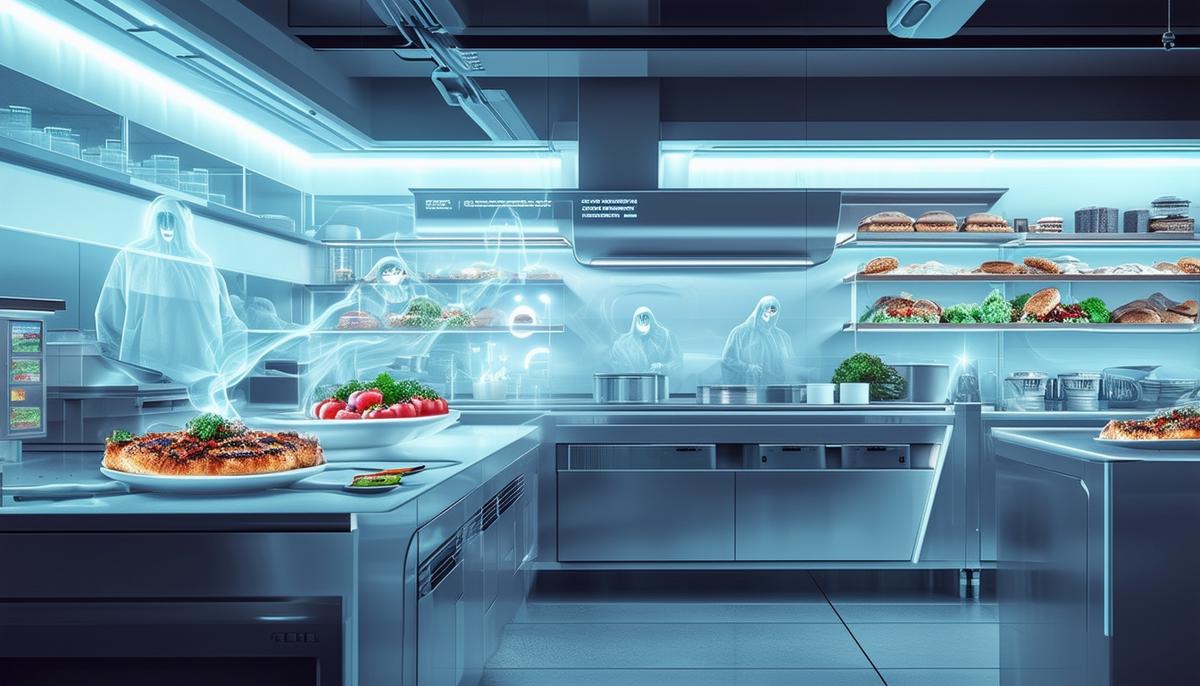The Emergence and Growth of Ghost Kitchens
Ghost kitchens, also known as virtual, dark, or cloud kitchens, saw significant growth during the COVID-19 pandemic. With traditional dining rooms closed, deliveries soared, and restaurants had to pivot quickly to survive. Ghost kitchens provided a lifeline for many, offering a way to continue operations without the need for a physical storefront.
Types of Ghost Kitchens
Ghost kitchens come in many shapes and sizes, each designed to suit different business models:
- Commissary Kitchens: These are shared spaces where multiple businesses prepare meals, allowing restaurateurs to scale production without a significant upfront investment.
- Commercial Kitchens: Dedicated solely to delivery and pickup, these kitchens operate independently of traditional dine-in services, minimizing costs by eliminating the need for a front-of-house.
- Dual-Brand Kitchens: Existing brick-and-mortar restaurants use their current kitchens to run an additional brand, maximizing kitchen utilization and broadening customer bases.
- Kitchen Pods: Portable and often housed in containers or trucks, kitchen pods are small but versatile, offering mobility and adaptability to high-demand areas.
- Pop-up Kitchens: Also known as incubator kitchens, these temporary setups in existing restaurant spaces offer a low-risk way to experiment with new concepts without significant investment.
Financial Perks and Operational Adaptability
Ghost kitchens offer financial benefits by eliminating the need for front-of-house staff and prime real estate, significantly reducing overhead costs. Without the burden of a physical storefront, resources can be focused on quality ingredients and efficient delivery operations.
Testing the Waters
Virtual kitchens make it easier to experiment in new markets, allowing businesses to test different cuisines and tweak menus based on real-time customer feedback. This agility is a significant advantage, enabling restaurateurs to launch multiple concepts from a single location.
Examples of Success
Some ghost kitchen ventures have found immense success. Reef, for example, expanded from a parking business to running 120 kitchens across 21 cities. By analyzing delivery and demographic data, they continuously iterate their models and thrive. Smaller operators, like Man vs. Fries, have also seen substantial growth, with sales multiplying fivefold without the hefty capital of traditional expansion.
Ghost kitchens emerged as an innovative solution to the challenges faced by the restaurant industry during the pandemic. Their financial efficiency, operational flexibility, and market potential offer a robust alternative to traditional dining, representing a shift in how we think about restaurant operations—a shift that many believe is here to stay.
Advantages and Challenges of Ghost Kitchens
A deep dive into ghost kitchens reveals several advantages, especially for entrepreneurs navigating the volatile restaurant industry. One of the most significant benefits is financial efficiency. Traditional brick-and-mortar restaurants require steep investments in prime real estate, decor, and a sizable front-of-house staff. Ghost kitchens strip those costs down to the essentials: the kitchen and the culinary staff. While the upfront investment for a traditional restaurant can soar to $1 million, a ghost kitchen may only need an initial outlay of about $30,000, depending on local permitting and operational complexity.1
Operationally, ghost kitchens excel in flexibility and scalability. These kitchens can be set up in weeks, not months, and the absence of a dine-in area means you can focus solely on food production and delivery efficiency. By operating out of less expensive locations, like industrial areas or outskirts, businesses can benefit from lower rent and operational costs, translating directly to improved profit margins. This model allows entrepreneurs to channel their resources into quality ingredients and faster, more reliable delivery services.
Market testing is another critical advantage. Ghost kitchens offer an unparalleled opportunity to experiment with various cuisines and menus without substantial economic risk. Restaurateurs can launch multiple virtual brands from a single kitchen, each targeting a different demographic or cuisine type. With real-time data and feedback from delivery apps, they're equipped to pivot quickly and adjust recipes, pricing, and marketing strategies to meet consumer demands.
However, these advantages come with their set of challenges. One significant issue is maintaining food quality during delivery. Since ghost kitchens are optimized for delivery, meals must be designed to endure travel time without losing their appeal. Poor quality or cold, soggy food can deter repeat business and harm the brand's reputation.
Trust and transparency also pose problems. Multiple instances have surfaced where customers complained about food quality or discovered identical menus from different brands operating out of the same kitchen. This lack of transparency erodes trust. Additionally, the viral case of Auntie Cammy running a kitchen out of her home exposed gaps in regulatory compliance and raised concerns about safety and authenticity.2
Increased competition remains a double-edged sword. As more entrepreneurs capitalize on the low entry barriers, the marketplace becomes saturated. While this abundance gives consumers a variety of choices, it also makes it harder for new entrants to stand out. Established companies with deep pockets might overshadow smaller, innovative operations, making it difficult for Mom-and-Pop ventures to gain traction.
Despite these challenges, the ghost kitchen market is projected to skyrocket, with experts forecasting it to reach a global market value of $1 trillion by 2030.3 Successful models demonstrate that with the right strategy, substantial profit can be realized. Conversely, high-profile struggles highlight that success requires more than just a good concept; it necessitates robust logistics, impeccable quality control, and adaptive business strategies.
In conclusion, while ghost kitchens offer substantial financial, operational, and market testing benefits, they must navigate significant hurdles in maintaining food quality, establishing consumer trust, and standing out in a crowded market. By addressing these challenges head-on and leveraging the flexibility and cost-efficiency of the ghost kitchen model, both budding and established restaurateurs can thrive in this evolving sector.

Technological Solutions Enhancing Ghost Kitchens
One major factor contributing to the success of ghost kitchens is their reliance on advanced technological solutions. Platforms like Bbot, Square KDS, and Marqii have revolutionized how these kitchens operate, streamlining processes and enhancing overall efficiency.
Bbot has developed an integrated platform specifically designed for ghost kitchens, addressing the fragmented nature of the industry. Multiple software systems historically required piecing together different applications at exorbitant costs. Bbot simplifies this by offering an all-in-one solution that allows operators to manage first- and third-party orders from a single KDS (Kitchen Display System). This centralized approach enables better order accuracy and faster fulfillment, putting the power back into the hands of the operators.
Square KDS takes this a step further with a feature-rich system compatible with multiple devices. It organizes digital tickets for back-of-house operations, reducing the chaos of manual order entry. This system also includes setting up online ordering pages and seamlessly integrating with delivery apps such as Chowly and Postmates. By consolidating online order reporting, Square KDS eliminates the risk of dropped tickets and reduces staff errors.
Additionally, Square's comprehensive suite of tools extends beyond order management. Their loyalty programs, payroll automation, and marketing solutions help ghost kitchens maintain customer engagement, optimize employee management, and execute targeted promotional campaigns. This holistic approach ensures that every aspect of the business, from cooking to customer retention, operates smoothly.
Marqii, on the other hand, focuses on enhancing online menu management and customer reviews, two areas that become increasingly complex when operating multiple virtual brands. The platform allows restaurants to manage their online menus and listings, ensuring that information like hours and menu items is always up-to-date across all platforms. This kind of automation saves valuable time and reduces the likelihood of errors, resulting in a more consistent customer experience.
One of Marqii's standout features is its Managed Review Response service, which combines AI and human intelligence to handle customer feedback carefully. Over 8,000 hospitality businesses use this service to track and respond to reviews promptly, fostering trust and improving their online reputation. This level of proactive management is crucial as consumers increasingly rely on reviews to make dining decisions.
Moreover, partnerships like Marqii's integration with MarketMan—a restaurant management system for inventory and accounting—demonstrate how critical tech stack integrations can be for ghost kitchens. By merging different operational aspects under one umbrella, these integrations break down silos, enabling more strategic decision-making and improving overall business efficiency.
Adopting these technological solutions allows ghost kitchens to scale more efficiently. Whether launching a new virtual brand or expanding an existing one into new markets, platforms like Bbot, Square, and Marqii provide the tools necessary to streamline operations and maintain consistency.
In essence, the ongoing advancements in technology are not merely accessories but foundational pillars supporting the ghost kitchen model. They bridge the gap caused by fragmented systems, enhance operational efficiency, and ensure that both new and existing restaurants can meet consumer demands head-on. As the sector continues to grow, leveraging these technological innovations will be indispensable for sustained success and scalability in the evolving landscape of foodservice.

Future of Ghost Kitchens: Trends and Predictions
As we look to the future of ghost kitchens, several trends and predictions can help guide restaurateurs and entrepreneurs in harnessing the continued growth and success of this innovative model.
Ghost kitchens are poised to remain a significant part of the restaurant industry, driven by the sustained popularity of food delivery. Since the pandemic, consumer preferences have increasingly leaned towards the convenience of having meals delivered directly to their doorsteps. This trend shows no signs of waning as more people opt for the comfort and safety of dining at home.4
One prominent prediction is the rise of 'second-generation' ghost kitchens, which will place a stronger emphasis on quality and customer experience. Unlike the early days of ghost kitchens, where speed and low costs were paramount, the future will see a more refined approach. These new-age ghost kitchens will prioritize food quality, consistency, and reliable delivery. The focus will shift towards creating memorable culinary experiences, even in a delivery-only model.
Large chains will play a crucial role in this next phase, leveraging their resources to meet the evolving demands of customers. Companies like Reef, which rapidly expanded during the pandemic, demonstrate how analyzing demographic data and delivery trends can help tailor offerings that match consumer desires. This data-driven approach will continue to be vital in ensuring the success of ghost kitchens as they adapt to market shifts.
Meanwhile, smaller players will need to find ways to distinguish themselves. With increased competition and growing consumer expectations, independent ghost kitchens will have to focus on niche markets or unique culinary concepts. They might also benefit from strategic partnerships and technological integrations.
As ghost kitchens evolve, there will likely be a consolidation in the market. Companies that can scale efficiently, maintain high quality, and manage consumer trust will emerge as leaders, while others may falter. The increasing reliance on technology to manage orders, streamline operations, and engage with customers will become even more critical. Platforms like Bbot, Square KDS, and Marqii are already setting the standard by offering comprehensive solutions that address operational challenges and enhance customer service.
Forecasts for market size project substantial growth. The global market value of ghost kitchens is expected to reach $1 trillion by 2030.3 This growth is not just driven by the convenience of food delivery but also by innovative business models that optimize resources and maximize reach.
Another notable trend is the emerging focus on sustainability and eco-friendliness. As consumers grow more environmentally conscious, ghost kitchens will need to adopt sustainable practices, from sourcing to packaging. Implementing eco-friendly solutions can not only attract environmentally-conscious customers but also reduce operational costs in the long run.
Ghost kitchens will also play a vital role in urban planning and development. As cities become more congested, traditional dine-in restaurants might face limitations in terms of space and accessibility. Ghost kitchens, which require less real estate, can provide a solution to this problem, offering high-quality food services without the need for expansive dining areas.
In conclusion, the future of ghost kitchens is bright, filled with opportunities for both large chains and smaller players to innovate and excel. By focusing on quality, leveraging technology, and responding to consumer needs, ghost kitchens can continue to thrive and redefine the restaurant industry. As this model evolves, those who prioritize customer experience and sustainable practices will likely lead the way, ensuring that ghost kitchens are a permanent fixture in the culinary landscape.

- Maze J. How much does it cost to start a ghost kitchen in 2023? The Restaurant Times. March 1, 2023.
- Toh M. A Malaysian woman's 'ghost kitchen' lands her in hot water. The Star. June 22, 2022.
- Euromonitor International. The $1 trillion global ghost kitchen industry is growing rapidly, finds new Euromonitor research. Cision PR Newswire. October 18, 2022.
- Kelso A. Ghost kitchens could be a $1T global market by 2030, says Euromonitor. Restaurant Dive. November 10, 2022.
Leave a Reply